Olioli
Harmless

Posts: 8
Registered: 29-8-2011
Member Is Offline
Mood: No Mood
|
|
Soxhlet extraction @.@ HELP!!
I dunno wats wrong, i'm tryin to extract oil from dried chili seed
I got the
a)Soxhlet extraction bath (Protech)
http://mymall.netbuilder.com.my/index.php?doit=order&pid...
b) Extraction Apparatus Complete Assembly (40/38 favorit)
c) Cellulose extraction thimble
d) Oven dried chili seed
Right so despite searching around, I cant :
1)find the typical raw material to volume solvent ratio= I tried 10g with 150mL of solvent
2) tried using n-hexane, set the water bath at 70C, but the solvent didnt boil despite 70C is its boiling point.So I set to 100C, n tadah the solvent
boils..So I dont get how some journals/published materials can site that they set the temp at 70C n it works. Can it be that my apparatus is not good
enough?
3) I use 6 extraction apparatus assembly on the water bath, and found that some extraction boils faster than the others..weird
3) Published papers wrote the experiment undergo 6 hours? 6 hours as in the time the apparatus is set in place? or when the 1st sign of extraction
happens (that is the 1st-few drops of evaporated solvent into the thimble?)
HELP!! Can someone enlighten me ><"""""
|
|
|
bbartlog
International Hazard
    
Posts: 1139
Registered: 27-8-2009
Location: Unmoored in time
Member Is Offline
Mood: No Mood
|
|
Can't answer most of your questions, but in order to boil/reflux a solvent you would need the water bath outside the vessel to be at a significantly
higher temperature than the boiling point of the stuff inside the vessel. Remember, you have to drive enough heat through the glass to do the work
(vaporization), and for that there has to be a temperature gradient, so higher-than-boiling temps outside. If some published materials suggest
otherwise, someone (either you or the author) is confused or just sloppy.
|
|
|
Ozone
International Hazard
    
Posts: 1269
Registered: 28-7-2005
Location: Good Olde USA
Member Is Offline
Mood: Integrated
|
|
1. It is an extraction process which constantly recycles (distills) fresh solvent. The volume ratio to sample is meaningless. You only need somewhat
more solvent (to prevent dryness upon minor loss) than is required to cycle the soxhlet. I usually use about twice the soxhlet volume.
2. hexanes boils at around 65°C, IIRC. So long as you have steady reflux and adequate cooling, overheating will be very hard to do. If your setting
works, go for it. If that is worrying to you, get a thermometer and calibrate the bath manually. Use boiling stones. Too bad CFC-113 is no longer
available, it was the BEST oil/grease solvent, ever.
3. Use boiling stones. Perhaps crank up your bath just a bit.
4. that would be 6 hours at reflux. I usually let them go over night.
-Anyone who never made a mistake never tried anything new.
--Albert Einstein
|
|
|
Olioli
Harmless

Posts: 8
Registered: 29-8-2011
Member Is Offline
Mood: No Mood
|
|
Thanks alot..
Thats why I set the water bath at 100C, and only then able to see the solvents boiling.
Weird, I Saw somewhere that:
- Volume of solvent does affect
-Temp at which the experiment is perform
*These become some sort of parameters in the experiment, especially for those trying to optimize the extraction**
Oh and should I
-pour some volume of solvent inside the thimble?
and
Any idea what is the water activity of the raw material sample prior to the start of the experiment?
** Sorry I ask alot >.<, I cant seem to find anyone to explain these to me****
|
|
|
chemrox
International Hazard
    
Posts: 2961
Registered: 18-1-2007
Location: UTM
Member Is Offline
Mood: LaGrangian
|
|
The picture you showed is something else. Are you using a rb-soxhlet-condenser setup? If so are you re-circulating solvent? If not something is
terribly amiss. Photo the apparatus in operation/non-operation/would-be operation and post that. If the issue is you're not coloring up the solvent
maybe the solvent is wrong. I think ethanol works for chili seeds. I use it for bilberry.
"When you let the dumbasses vote you end up with populism followed by autocracy and getting back is a bitch." Plato (sort of)
|
|
|
fledarmus
Hazard to Others
  
Posts: 187
Registered: 23-6-2011
Member Is Offline
Mood: No Mood
|
|
If you think about it, it really isn't your pot temperature that you want at the boiling point of your solvent. The boiling point is also the
condensing point, and you want that temperature to be above your thimble, so the solvent will stay in a vapor until it gets above the thimble, then
condense and drop down into the thimble. Ideally, the oil you are trying to extract will be dissolving in hot solvent, only slightly below the boiling
point. This is why you need to set your water bath so much above the boiling point - you aren't just trying to boil the solvent, but to warm enough of
your apparatus that the solvent vapor won't condense until it is above your sample.
As for the amount of solvent, as Ozone said, it doesn't really matter. The boiling point of the solvent will be lower than any of the oils you are
extracting, so only the solvent will boil. (If the components you are trying to extract have a lower boiling point than your solvent, you should be
trying to distill them rather than extract them.) Regardless of how much material you have pulled down into the pot, the material condensing above
your sample will still be pure solvent. Okay, that's a little more absolute than is really the case, but not too bad of an approximation.
As for time, that depends on several factors - the purity you desire in your recovered oils, the size of the sample you are extracting, the volume of
hot solvent you can condense, the particle size of the sample, and so on. I'm sure with some thought you could add a number of other factors to this
list yourself. There are multiple components in your sample, and some of them will be more soluble than others in your hot solvent. Your most soluble
components will be enriched in the pot at the beginning of your extraction, and less soluble components towards the end of the process, as the more
soluble components have all been washed down.
[Edited on 1-9-2011 by fledarmus]
Try not to just blindly follow a recipe - think about the physical processes going on in your extraction, and adapt or adopt the recipe to give you
the outcome you want.
[Edited on 1-9-2011 by fledarmus]
|
|
|
Olioli
Harmless

Posts: 8
Registered: 29-8-2011
Member Is Offline
Mood: No Mood
|
|
I have to have a some sort of " General Standard procedure" to follow on.If I just want to extract the chili oi, I can play around, adapt and change.
But I am trying to Optimize the extraction.
So i guess particle size, solvent volume, moisture content of raw material, temperature and so forth does play a role as parameters.
(Adding to which, I cant seem to find the General/standard for these raw material/solvent ratio, moisture content, particle size etc)
I'm not quite sure if I can optimize the temperature of the solvent, since the temperature of the waterbath is different than the solvent. I set it
100C, the temperature in the solvent was found to be 70C. Perhaps this is only applicable if Soxtec were in used, and not the conventional soxhlet.
I wont reuse recycle solvents especially since this is about optimizing the process.
Flat bottom flask is used.
I attached some pictures just to let you guys see..
perhaps somewhere in my methods is amiss.
Thanks guys
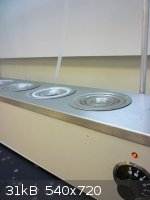 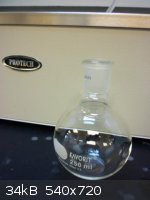 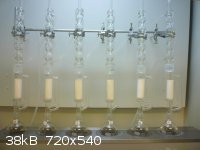 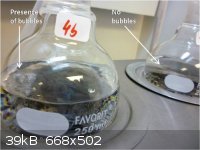
|
|
|
Olioli
Harmless

Posts: 8
Registered: 29-8-2011
Member Is Offline
Mood: No Mood
|
|
And continue pics here:
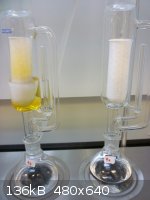 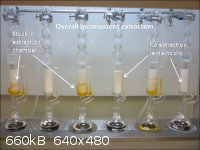
|
|
|
fledarmus
Hazard to Others
  
Posts: 187
Registered: 23-6-2011
Member Is Offline
Mood: No Mood
|
|
Quote: Originally posted by Olioli  |
I'm not quite sure if I can optimize the temperature of the solvent, since the temperature of the waterbath is different than the solvent. I set it
100C, the temperature in the solvent was found to be 70C.
|
Your choice of solvent determines your temperatures. The pot and the apparatus up to your condensor needs to be at a temperature higher than the
boiling point of your solvent, so that the vapors will travel all the way up to the condensor. Don't worry too much about the difference between the
heat source and the liquid inside the flask - as long as there is liquid boiling, the temperature will be very close to the boiling point of the
liquid.
Just a couple of comments on your setup. First, you have very little of your flask exposed to the heat. This could explain the differences you see
with some containers boiling and some not boiling. Usually I like to have as much of the flask as I can exposed to the heat, but not higher than the
surface of the liquid inside. This allows for more efficient heat transfer to the liquid.
Second, you have a lot of apparatus above your flask to fill with hot vapors. Any part of that apparatus can act as a place for the vapors to
condense, and if that is lower than your condensor, the solvent will simply be flowing back into your pot without going through your sample.
Insulating the parts of your apparatus below the condensor will allow you to reduce the temperature of your water bath without slowing down the
extraction. I would use a ~1" layer of glass wool with a layer of aluminum foil to hold it in place, from just above the surface of the liquid (so you
can still see in and watch it boil) up to the base of the thimble, and more insulation around the sidearm leading up to the condensor.
I understand your earlier question about pouring some volume of solvent inside the thimble now, from your pictures. No, you don't want to pour the
solvent inside the thimble before you start the extraction, but you do need to add that much extra solvent to your pot to account for the holdup in
your condensor.
These suggestions should at least get all six of your systems extracting so you can experiment with the rest of your variables.
|
|
|
Olioli
Harmless

Posts: 8
Registered: 29-8-2011
Member Is Offline
Mood: No Mood
|
|
Thank You..I shall try that..
I Do have something to ask, when should I start timing my experiment. Because I might wan to use time as a parameter.
Thanks
|
|
|
fledarmus
Hazard to Others
  
Posts: 187
Registered: 23-6-2011
Member Is Offline
Mood: No Mood
|
|
It seems to me that the most informative place to begin timing would be when your first drops of condensate begin falling into your sample. This would
give you the time that the sample was exposed to the hot solvent, which would most directly relate to the amount of material extracted by the solvent.
This would also be the most time-consuming to measure, because it would require you to observe and record each still separately. There might also be
variability from still to still on how fast the solvent is condensing, and counting drop-rate might also be useful to get a good picture of the total
amount of solvent passing through your sample.
The easiest time to measure, of course, would be the time from when you turned on the heat to when you turned it back off, and that might also be the
most relevant time if you are trying to design a simple, robust, repeatable procedure.
|
|
|
Olioli
Harmless

Posts: 8
Registered: 29-8-2011
Member Is Offline
Mood: No Mood
|
|
What do you guys think?
From the picture you can see that the solvent in the pot isnt in much contact to the waterbath..What if I remove completely the waterbath cover and
use a 500mL pot/flask instead? Probably that way the solvent will be expose more to the waterbath heat.
|
|
|